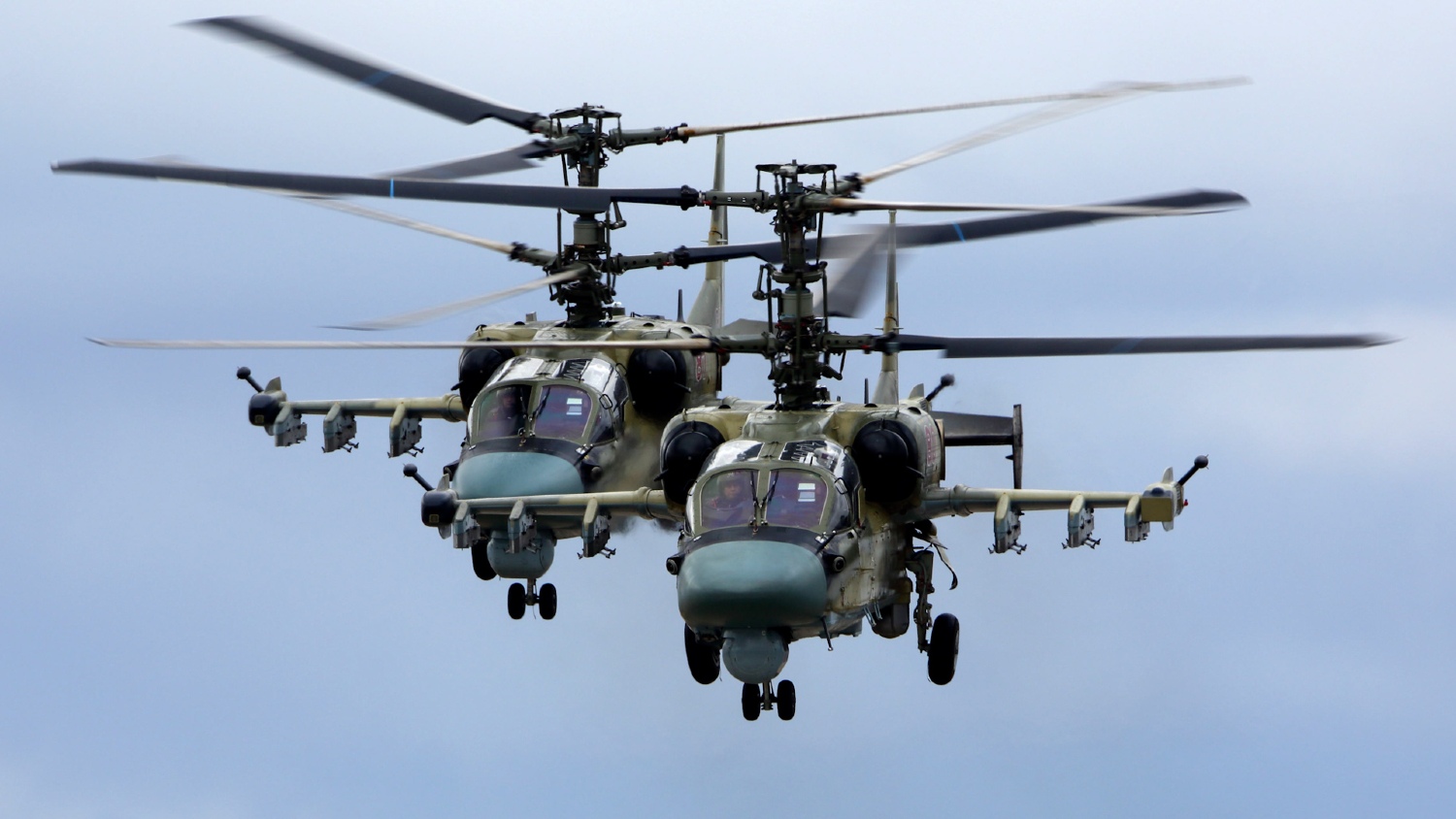The Russian Ministry of Defense (RuMoD) has released a video of the Kamov Ka-52 Alligator flying night-time sorties and destroying a Ukrainian tank in a rare combat display in all-weather conditions and low visibility.
This would be scarce footage of night fighting by either of the sides in general and the Ka-52 in particular, which, despite its losses, has been largely credited with blunting the Ukrainian counteroffensive by flying anti-armor missions.
Interestingly, the RuMoD’s footage is also timed with the Dubai Air Show, where the Ka-52 has been a surprise addition to the static display. Russian officials report much interest from even Western countries, which are curious about the helicopter’s capabilities.
The footage shows one of the pilots doing preflight checks on the engine and the weapons stubs, wearing night-vision helmets, and then strapping themselves into the cockpit. Two Ka-52s can be seen on the tarmac, taking off, then flying a distance beside each other, captured in the green-toned night vision footage.
It is unknown if this helicopter providing the first-person view footage is also a Ka-52 or any other helicopter. It is possible it could be a Mi-8 MTPR-1 electronic warfare (EW) helicopter that often flies in pairs with the Alligators, providing jamming and counter-jamming support.

Video Shows Ka-52 Night-Time Raid
A brief shot in non-NV mode captures a pilot’s pressing down on a button on the control stick. A thermal view from an electro-optical system then shows an anti-tank guided missile (ATGM) flying toward a stationary land target, possibly a tank or an Infantry Fighting Vehicle (IFV).
It is possibly the Vikhr ATGM and its impact on the tank causes a massive explosion. Whether the tank survived the strike is unknown, but the inferno’s intensity suggests it would have been rendered severely inoperable.
June to August this year had seen the Ka-52s featured in dozens of RuMoD videos launching Vikhr ATGM from five to seven kilometers in support of ground troops in trenches and the defensive lines trying to prevent Ukrainian breakthroughs.
Modernized Ka-52M Alligator
This version of the Ka-52 could be assumed to be the modernized ‘M’ variant (Ka-52M), which reached Russian units in January in anticipation of a tank war breaking out with Western-made armor. This was touched upon in a previous EurAsian Times analysis.
Interestingly, Russian defense industry officials had pointed out enhanced night fighting capabilities as one of the Ka-52M’s defining features. It has a new GOES-451M Electro-Optical System (EOS) turret mounted under the nose, with a more prolonged viewing range.
Without identifying the new sighting system, a TASS report from October last year said it would expand the possibilities of using weapons at night. “The range of detection and recognition of the target of the thermal imaging channel of the upgraded sight has been doubled,” it added.
The presence of domestically produced heavy-class helicopter gunships put Russia in a better place to successfully hold off an armored thrust since it also possessed tanks, ground-launched anti-tank weapons, loitering munitions, and artillery.
The Russian MoD released a video of the Kamov Ka-52 Alligator flying night-time sorties and destroying a Ukrainian tank in a rare combat display in all-weather conditions and low visibility. #UkraineWar pic.twitter.com/erWCJne4fO
— EurAsian Times (@THEEURASIATIMES) November 14, 2023
In October, RIA Novosti reported that the Ka-52Ms would also receive a ventral all-round radar station operating in the centimeter range. “These stations will allow helicopters to detect a wide range of air and ground targets, such as enemy aircraft, helicopters, UAVs, armored vehicles, artillery positions, concentrations of manpower and other military personnel, and objects, including in high-detail radio vision mode,” RIA Novosti reported an unnamed source.
This would allow the Ka-52M to conduct all-weather and round-the-clock reconnaissance and target designation in potent natural and artificial radio interference conditions. In particular, the helicopter can detect targets with low radar contrast.
Until now, the Ka-52 has been equipped with the Phazotron-NIIR FH01 Arbalet-52. The helicopter’s nose houses a 31.5-inch mechanical radar antenna for a Ka-band (8-millimeter wavelength).
However, a significant feature has been the introduction of the GOES-451M electro-optical system that enhances target designation and tracking at longer ranges than the older GOES-451 EO turret.
It can also be assumed to amplify the capabilities of the 14.5-kilometer range LMUR air-to-ground (AGM) guided missile. The missile’s developer, the Yekaterinburg-based UOMZ JSC, claims a tank detection range of 9.3 miles (15 km) via TV/CCD camera guidance and 12.5 miles (20 km) using the thermal imaging view.
Russia Making Up For Weakness In Ground Night-Time Warfare
Russian night-time aerial strikes also make up for its infantry’s and ground units’ weakness in night warfare, owing to a lack of NV and thermal imaging equipment.
A Business Insider report from June 19 noted how Ukrainians, flush with Western arms donations, had recorded massive tactical successes against Russian positions on the frontline during nighttime raids.
However, Russia seems to have compensated by having larger semi-strategic systems like night-capable attack helicopters, which are also domestically made and not foreign hardware, unlike Ukraine, which is now totally dependent on US and European arms supplies.
- The author can be reached at satamp@gmail.com
- Follow EurAsian Times on Google News




